
Cats
From 8 Pounds to 800… a Cat Is a Cat!

Cats
From 8 Pounds to 800… a Cat Is a Cat!
Wow … great question!
A cat is a furry pet that purrs, plays, and pounces on unsuspecting mice. A cat is a jungle creature with huge fangs and a terrible scream. A cat is a plains animal, hunting antelope and zebras in Africa or tapirs and javalinas in South America.
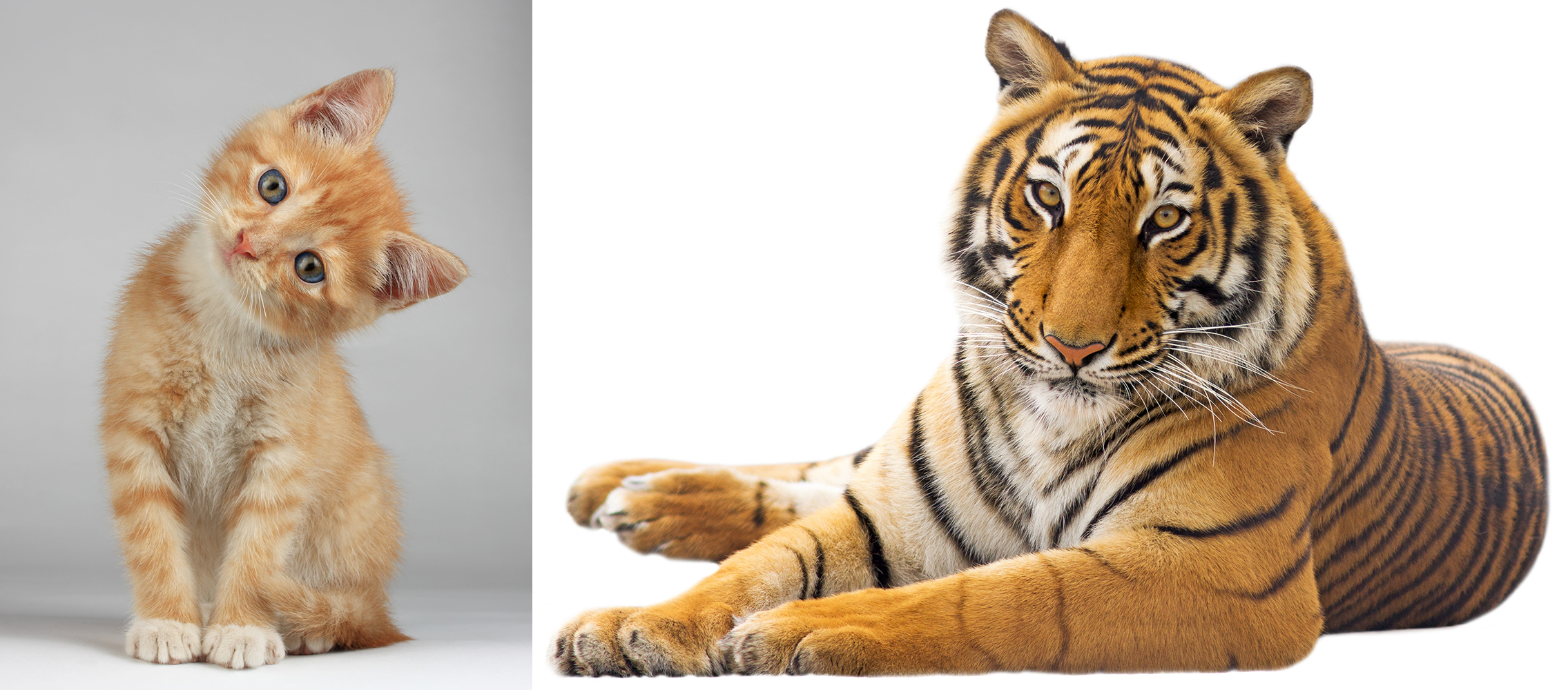 In a way, if you've seen one cat, you've seen them all. In a way, if you've seen one cat, you've seen them all.
|
In a way, if you’ve seen one cat, you’ve seen them all. There are minor differences, of course. Some are big, like lions and tigers; some are medium-sized like bobcats and ocelots, and some are small like desert cats and house cats. Wild cats tend to have tawny, spotted, or striped patterns for camouflage in their jungle, forest, or plains habitat, but domestic cats come in a plethora of patterns and colors. Lions live in family groups called prides, but most wild cats live solitary lives. Domestic cats fall somewhere in between with feral populations often living in loose-knit colonies and house pets adjusting to life in either a single cat or multiple cat household.
The differences are subtle, but the similarities are both unmistakable and striking. Bone and muscle structure, teeth, eyes, ears – all say “top predator.” No matter size or coat color or type of prey, all cats have strong, agile bodies, a remarkable sense of balance, retractable claws, quick reflexes, and sharp teeth for killing. From the eight pound house pet to the 800 pound tiger, a cat is a cat is a cat.
Scientists sequencing the cat genome found physical and behavioral markers in the domestic cat that do not exist in their wild cousins. Chief among these differences are behaviors such as memory, fear, and reward-seeking, all considered important in the domestication process. In addition, they found markers for coat color and texture changes that do not exist in the wild.
Like their larger and wilder cousins, domestic cats have large fangs for grasping the necks and snapping the vertebrae of prey animals and teeth suited for chewing an all-meat diet. They have excellent hearing with a range far more extensive than either humans or dogs and large eyes with binocular vision to provide depth perception and a wide field of sight that completes the package. The interior structure of the cat’s eye helps it to see in dim light and its sensitive whiskers help it maneuver through tall grass, scrub growth, and brush piles in search of prey. While acute, the cat’s sense of smell is not as keen as that of a dog and is not a primary hunting adaptation.
Domestic cats tend to be more social than their wild relatives and use a broad repertoire of sounds to communicate with each other and the humans in their households. They purr, scream, growl, trill, grunt, and hiss, and have a range of meows that broadcast their mood or indicate a need.
All in all, domestic cats are consummate hunters with an affinity for life among humans, either foraging at the fringes or curled up on the couch.
The association between cats and people probably began in the Middle East about 9000 years ago, following the advent of agriculture in the Fertile Crescent, a swath of land stretching from the Nile River in Egypt to the Persian Gulf. The cultivation of grains allowed nomads to become settlers and crop storage provided cats with a ready source of rodents for food.
 Cats were revered in ancient Egypt -- thousands were mummified! Cats were revered in ancient Egypt -- thousands were mummified!
|
Cats adapted to the presence of people, but were not domesticated until the Egyptians recognized their value as dispatchers of vermin about 4000 years ago. The Egyptians brought cats into their homes, honored them as hunters, celebrated them as gods and goddesses, depicted them in art, and even mummified them before burial.
 Cats have a long history of protecting human food and manuscript from rodents. Cats have a long history of protecting human food and manuscript from rodents.
|
Other civilizations followed the Egyptian example, and cats spread throughout the ancient world from Egypt to Greece, then throughout Europe with the Romans. Some evidence puts them in the Far East about 5300 years ago, where they lived in Chinese farm villages and probably protected millet stores from rodents. European monks and ancient librarians also kept cats to prevent manuscript and book damage by rodents, a tradition that carries on in libraries today.
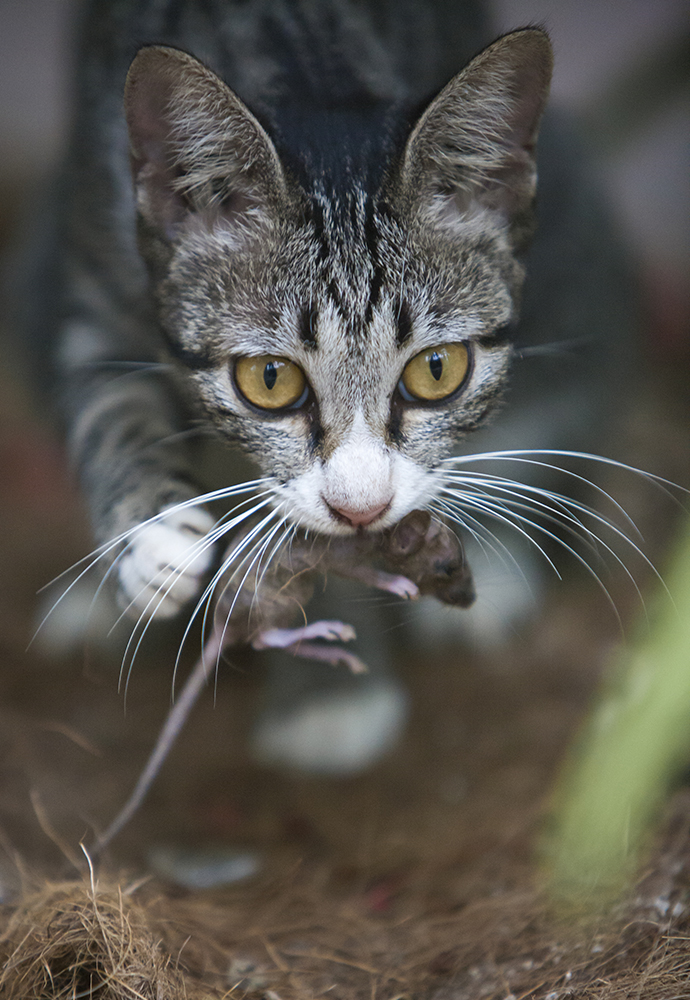 Cats were often killed on sight in the Middle Ages, which may have contributed to or prolonged the Black Plague. Cats were often killed on sight in the Middle Ages, which may have contributed to or prolonged the Black Plague.
|
But all was not rosy for this curious, adaptable, stealthy feline. During the Middle Ages, Europeans associated cats with evil, banned ownership, and often killed them on sight, a colossal mistake in judgment that some historians believe contributed to the devastating Black Plague that killed 25 million people from 1347-1352. Although the pneumonic form of the disease spread primarily from person to person, rat fleas carried the bacterium and provided reservoirs of infection; the war on cats threatened the rats’ major predator and might have prolonged the agony of the outbreak.
Superstitions linking cats to witches and demonic spirits faded over the next two centuries and by the 1600s, cats were again welcomed into households as pets and rodent control.
The Pilgrims and other early settlers brought cats to the New World as ratters on their ships, and the cats excelled in their role as predators of vermin in food supplies on the ocean and in the new land.
Unlike the dog, the cat changed little in the intervening centuries. Humans bred dogs with particular characteristics to do jobs ranging from flea magnet and bed-warmer (toy breeds) to guarding, hunting, tracking, and herding, but cats were already well-suited for their role in civilization – they kept rodents out of grain supplies and away from precious documents with no training or selective breeding.
No doubt, cats are supremely adapted to exploit their environment. Today, there are hundreds of millions of cats in the world and tens of millions kept as pets in the US. Acquiring a cat is easy: the neighbor’s cat has kittens, a stray wanders onto the porch, a local shelter has an adoption drive, there’s a lone kitten in the pet shop window, etc. However, making an informed decision to bring a particular cat into your home requires some forethought.
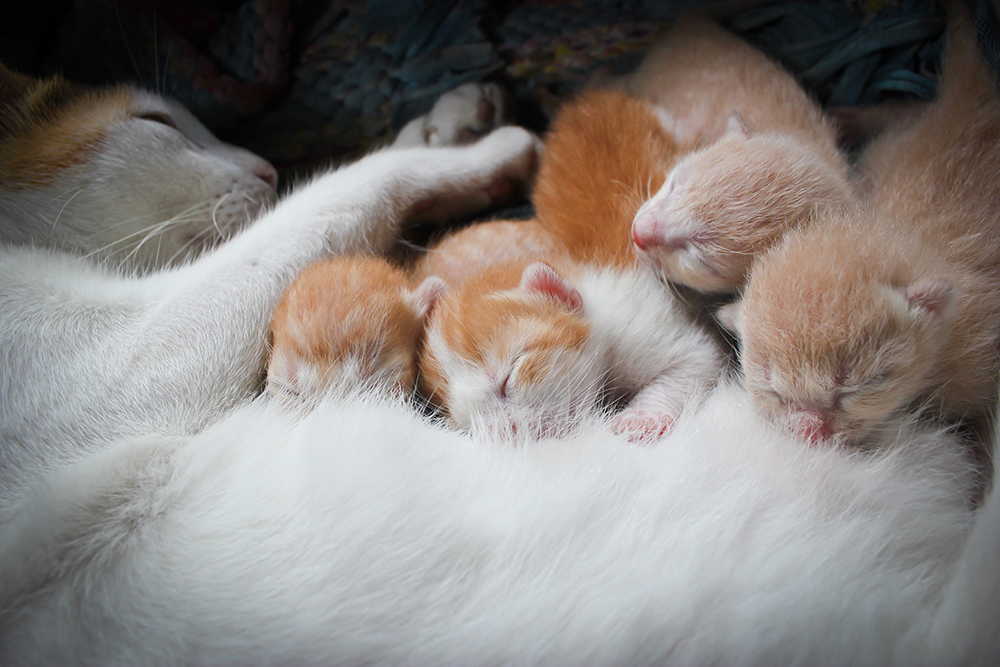 Kittens cannot see, hear, or regulate their body temperatures. Kittens cannot see, hear, or regulate their body temperatures.
|
Cats give birth to tiny kittens that cannot, see, hear, or regulate their body temperatures, but these little ones grow quickly. By two weeks of age they can see, in another week they can hear. Around four weeks, they can walk – although wobbly at first – and by five weeks they begin to taper down on mother’s milk and eat on their own.
Kittens handled from birth become accustomed to pleasant interaction with people. Petting, touching ears and feet, and checking teeth and gums from the start will help a kitten adjust to handling by new owners, a veterinarian, and other people he comes in contact with later in life. This socialization is critical for a successful transition from birth home to new family, a factor that breeders of pedigreed cats, owners of domestic cats that produce an accidental litter, caretakers of stray and feral kitten litters, and buyers or adopters of any of these kittens should know and practice.
Cats are independent creatures; like human teenagers, they often live alone with the rest of the family, seeking closeness and offering respect on their own terms. These characteristics make early handling and socialization critical to easy integration into a household.
Kittens should remain with littermates and mother cat for up to 10 weeks of age to learn how to be a cat. During this time, kittens learn to inhibit their bites and scratches from brothers and sisters and to hunt and react to changes in their environment by mother cat. For example, if a cat startles at loud noises, hisses and spits at a dog, runs away at the approach of a human, or bristles at the touch of a human hand, kittens are likely to follow suit.
Pet cats have the same hunting abilities that their feral cousins and distant wild relatives use to stay alive. Kittens have the necessary instincts and sharp claws and teeth to develop these skills by stalking and attacking moving objects, and they sharpen their claws on immovable objects to keep them in top working condition. Obviously, these behaviors can be problematic in families with small children or elderly adults with thin skin. Time in the litter and handling by humans helps teach them to keep claws sheathed and mouths closed when interacting with people. In addition, they become accustomed to grooming, nail trimming, petting, and other types of attention from people.
Kittens are subject to upper respiratory infections, so you should make sure the kitten isn’t coughing, that his eyes are clear, and his nose is free of discharge. He should also have a clean, unmatted coat and be free from worms.
In addition to appearing healthy, a kitten needs vaccinations to prevent common diseases. Veterinarians divide vaccines into two categories: core vaccines and non-core vaccines. The American Association of Feline Practitioners recommends core vaccines for all cats beginning with kittens at six-to-eight weeks of age. Core vaccines protect against Feline panleukopenia (FPV), Feline calcivirus (FCV) and Feline herpesvirus-1 (FHV-1). This vaccine series includes two or three boosters over a period of two to three months followed by an annual vaccination or a three-year vaccination for continuing protection.
Non-core vaccinations depend on the cat’s lifestyle. For example, if your cat spends time outdoors or in the company of other cats, your veterinarian may recommend vaccination to protect from feline leukemia virus, feline immunodeficiency virus, or feline infectious peritonitis.
AAFP considers rabies vaccination as non-core for indoor cats unless local or state laws require it or the disease is endemic in your area. All warm-blooded animals including humans are potential rabies victims. The disease is spread through bites or scratches from infected animals and is fatal once symptoms arise. Cats that spend time outdoors are at risk, especially in areas with populations of bats, skunks, foxes or raccoons that may harbor the disease. Many states mandate vaccination of all cats and dogs in areas where rabies is found in local wildlife, and some jurisdictions extend the requirement to pet ferrets.
Pedigreed or “generic” cat?
Long-haired or short-haired?
Male or female?
Adult cat or kitten?
 While all domestic cats have similar bodies, sizes, and behaviors, there are still many decisions to make! While all domestic cats have similar bodies, sizes, and behaviors, there are still many decisions to make!
|
If you opt for a kitten, look for one that is at least eight-to-ten weeks old and has had some initial socialization and health care. The source may be a breeder, a cat owner who failed to spay the queen before she became pregnant, a stray cat caretaker, a shelter, or a pet store.
A kitten accustomed to handling has a friendly attitude and a willingness to be picked up and held. He may purr, rub his head against your hand or arm or move his feet in a kneading motion (claws sheathed) against your body. He does not hiss, spit, or raise hackles at an approaching hand or cower in a corner.
If you select a generic kitten, find out as much as you can about mother cat. Was she a stray? Did she have her kittens in a house, under a porch, in a barn? Is she friendly? Was she healthy? Answers to these questions help you prepare for the personality of your kitten and potential health problems.
If you select a pedigreed kitten, ask the breeder about breed characteristics and general health. For example, the Maine Coon Cat has a loving nature, is especially good with children and is a good mouser. It is a large, active cat with long hair and it comes in many colors and patterns. Female Maine Coon Cats can weigh up to 12 pounds while males may tip the scales at 20 pounds or more.
In contrast, the Havana Brown is a medium-sized, short-coated sleek cat that comes only in shades of rich mahogany brown. The Brownie is also affectionate but carries an air of mischief.
For more about cat breeds, visit Cats Center Stage.
If you select an adult cat from a breeder, shelter, rescue, friend, or family member, ask about its previous life, health, and behavior. Some adult cats enter shelters and rescues as strays. Some owners surrender cats because they constantly dart out doors and return home pregnant. Some cats never learn to sheath their claws and frequently scratch people or leave furniture and drapes in tatters. Some cats have chronic battles with ear infections, upper respiratory disease, or other health problems that require periodic treatment. The more you know, the better prepared you will be when integrating a particular adult cat into your household.
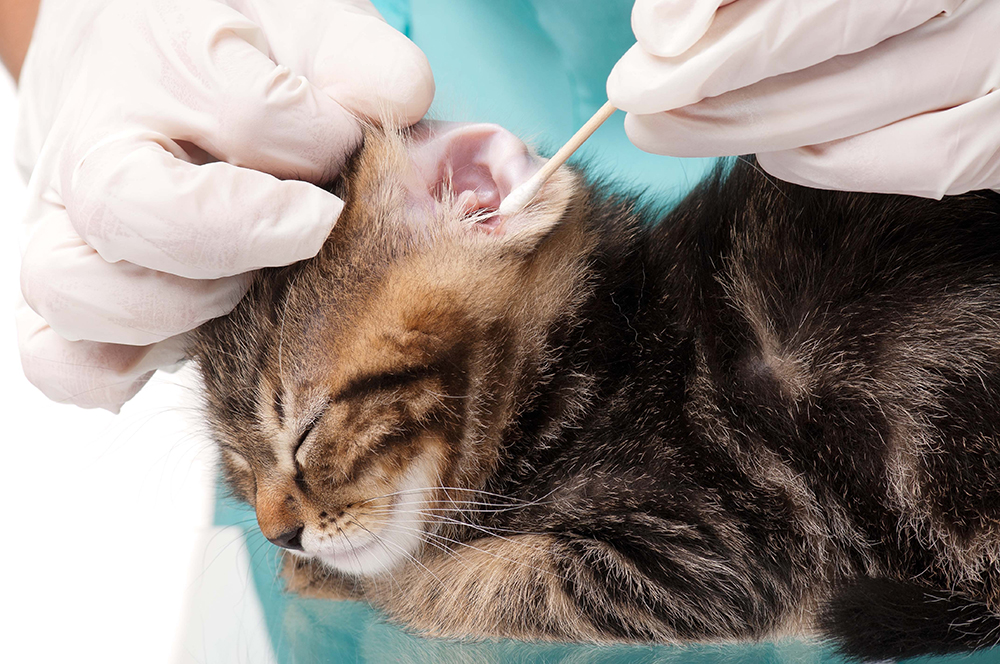 Some cats have chronic battles with ear infections, upper respiratory disease, or other health problems that require periodic treatment. Some cats have chronic battles with ear infections, upper respiratory disease, or other health problems that require periodic treatment.
|
For more information about cat selection, visit Cats Center Stage Videos.
Actually, the sex of a cat is a minor consideration if you plan to spay or neuter at the appropriate age. If left intact, female cats generally cycle twice a year, but if not bred, they may continue to cycle every few weeks until breeding takes place. Intact male cats will wander and fight while hunting for a female. Cartoons that show an annoyed resident throwing objects at yowling cats after a night of disrupted sleep are no joke: cats seeking mates are noisy and scrappy and not easily dissuaded from their quest.
Female kittens can have their first breeding cycle before they reach six months of age; males become fertile a few months later. Intact male cats spray strong urine to mark their territory and both males and females can have some behavior changes as well. It’s also hard to keep intact cats at home; they can slip outside through a barely open door or window in a trice, and fences and leashes are no help at all.
There are no studies that indicate a downside to early spay and neuter in cats, so there’s no current medical reason to wait until the kitten becomes a cat and management becomes a problem.
This is possibly the biggest decision for a prospective cat owner. Cats are notoriously clean animals. They groom themselves with a rough tongue and even “wash” their faces and ears by licking a paw and using it like a washcloth. But even the most fastidious cat cannot keep long hair from matting, a fact that may make daily grooming essential.
Cats should be accustomed to grooming as kittens or they may object to brushing and combing, especially if mats have already formed in their fur. While this is relatively easy to do with a kitten handled from birth, it can be a big problem with a cat acquired as an adult.
Many people and cats enjoy the bonding that occurs during grooming sessions. These cats purr contentedly when combed in a lap or on a table, and owners find pleasure in the calming, repetitive grooming strokes.
Skimping on grooming a long-haired cat is not an option. Tangled hair close to the skin hurts the cat, making it likely to run and hide when the grooming tools come out. Dirt and other debris get caught in long hair, especially if the cat spends time outdoors. Because they groom themselves with sandpapery tongues, cats often swallow loose and dead hairs and develop hairballs that can cause digestive problems. Usually, the cat passes the hair through the intestinal tract with no problem, but sometimes, especially as the cat ages, he vomits a “ball” of squishy, slimy material that is actually tubular, not round. So, if you have your eye on a fluffy Persian, Himalayan or other long-haired feline pet, buy a set of grooming tools and be prepared to use them every day if necessary.
As with dogs, the value of a pet cat lies in its capacity to satisfy the needs and wants of its owner. These characteristics include physical appearance and behavior. While owners seldom acquire a cat for its ability to do a job or compete in a sport, looks and behavior are important when making a choice. Do you admire the sleek look of a feline in Egyptian art? Does the flash of a calico cat catch your eye? How about the talkative nature of the Siamese? Or the prospect of a fluffy feline gracing the back of your living room sofa? These may seem like superficial reasons for acquiring a particular cat, but since your pet may live 20 years or more, you may as well get one that appeals to your eye.
Pedigreed cats come in specific colors and patterns. Siamese, Himalayan, Burmese, and Balinese cats are pointed, that is, they have light-colored bodies and dark ears, face, feet, and tails. Havana Browns, Korats, Russian Blues, and Bombays are solid colors. The Ocicat is reddish and spotted, and many other breeds are tabby-striped or patched in colors ranging from gray, red, or orange to calico or tortoise shell. The Maine Coon cat has dozens of color and patterns ranging from solids (white, black, blue, red, or cream) to tabbies, calicos, tortoise shells, and color patches with white.
Random-bred cats come in all of these colors and patterns as well and are easier to find than pedigreed cats bred to meet a standard of perfection and exhibit particular characteristics. Breeders of pedigreed cats generally pay more attention to cat health to guard against diseases and minimize genetic defects such as food allergies, inherited diabetes, hypertrophic cardiomyopathy, cataracts, asthma, cleft palate abnormalities, allergy-associated skin inflammations(3), and feline lower urinary tract disease.
You can find random-bred cats in shelters, rescues, and pet stores and from friends and neighbors who do not confine their unsprayed females.
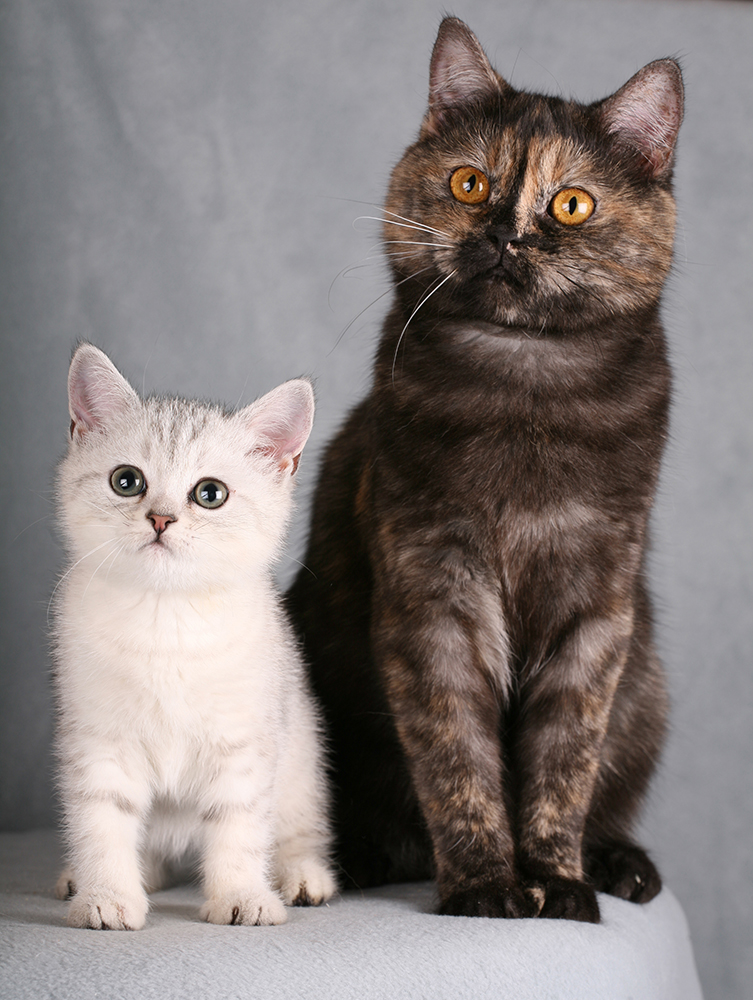 Kitten and Cat... both great pets! Kitten and Cat... both great pets!
|
It’s fun to raise a kitten. These appealing little felines can be a laugh a minute as they practice hunting skills in the living room or kitchen; climb in and out of shoes, boots, cabinets, or boxes; and curl up in nooks and crannies around the house. They can also try the patience of the most dedicated cat lover as they climb the curtains, sharpen claws on the furniture, topple the Christmas tree, or refuse to come out from under the bed. Kittens may bite when you try to trim their claws, comb their fur, or detach them from the living room drapes. If the downside to these young felines isn’t your cup of tea, you can avoid a lot of trouble by acquiring an older kitten or an adult cat that is past the curtain-climbing, furniture clawing, litter-box training months and is ready to settle on your lap or sofa-back.
When selecting an adult cat, look for one that appears healthy, is friendly, and has a health and behavior history to help you decide if you want to take on a pet with medical problems or bad manners.
In general, be wary of cats and kittens picked up as strays or trapped in feral cat colonies because they are more likely to have health and behavior problems and less likely to accept an indoor life than cats raised in a household by a breeder or a previous owner.
Cat declaw surgery removes the claw and the end toe joint. It is painful for about a week after surgery and can have complications such as infection or hemorrhage. It does not remove the cat’s instinct to scratch.
As noted above, long-haired cats need grooming, but this is just the tip of the iceberg. Cats also need a litterbox, a place or several to sit and watch the world, a scratching post, a carrier for car trips to the groomer and veterinary clinic, and toys.
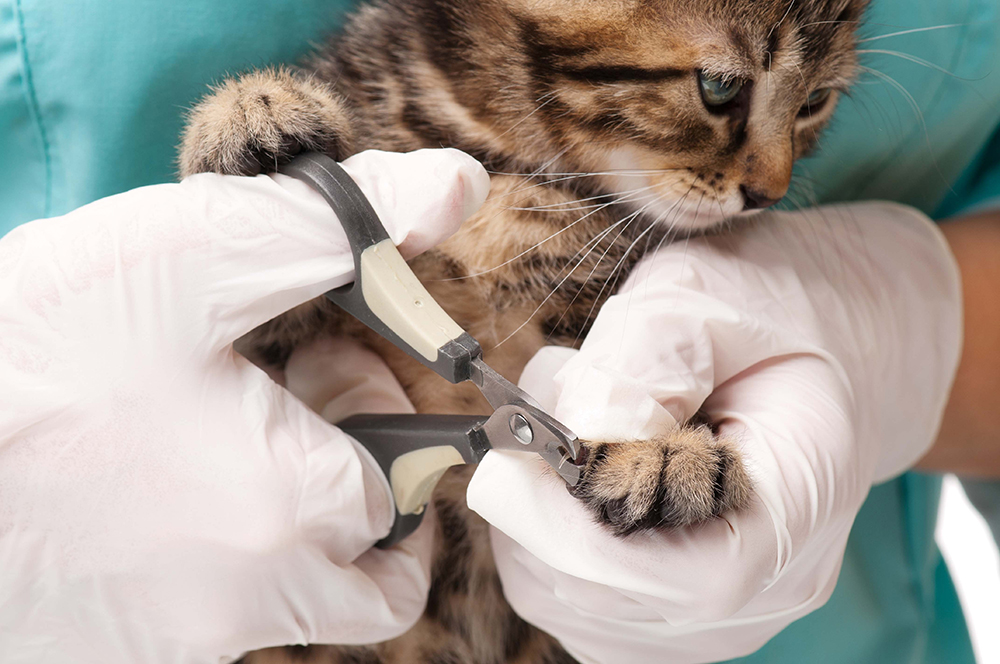 Good grooming includes nail-trimming. Good grooming includes nail-trimming.
|
All cats need some grooming, and good grooming includes nail-trimming. Cats have retractable claws that need sharpening and periodic trimming. If you don’t provide a scratching post, they’ll improvise by clawing the drapes, the furniture, and even your pantleg. Use your fingernail clippers for nail trims. Simply place the cat in your lap, hold a paw in one hand, hold a paw in one hand, press gently on the pads with your fingers until the claws appear, and clip the ends. Repeat on each paw. Give a small treat as necessary, after each paw for compliant pets, after each nail for those that are still learning the routine.
Many cats dislike having their feet handled, so before you attempt to trim, spend a little time handling each foot in turn and giving treats as the cat becomes more submissive.
If your cat throws a hissy fit over claw trimming, Cats Center Stage has some nail advice.
If you can’t resist adding more cats to your household, be sure to provide several litter boxes and to keep them clean. Many cats won’t use a box after another cat has soiled the litter.
Some cat owners opt to declaw their cats and avoid the hassle of trimming. Declawing also prevents the pet from scratching small children and elderly relatives with thin skin that is easily broken. The Cat Fanciers Association discourages declaw surgery because it does not benefit the cat, and instead encourages owners to trim nails or use nail covers and provide appropriate surfaces for the cat to scratch. CFA acknowledges that declawing may be necessary if owners have a high risk of injury or infection from cat scratches.
Cats are fastidious animals and can easily be trained to use a litter box where they can bury their waste. Owners should scoop the box at least daily to avoid odors and lapses in use, completely clean it every few days, and place it in an accessible area such as a bathroom. If the box is in the garage or basement, the cat should have his own door for entry.
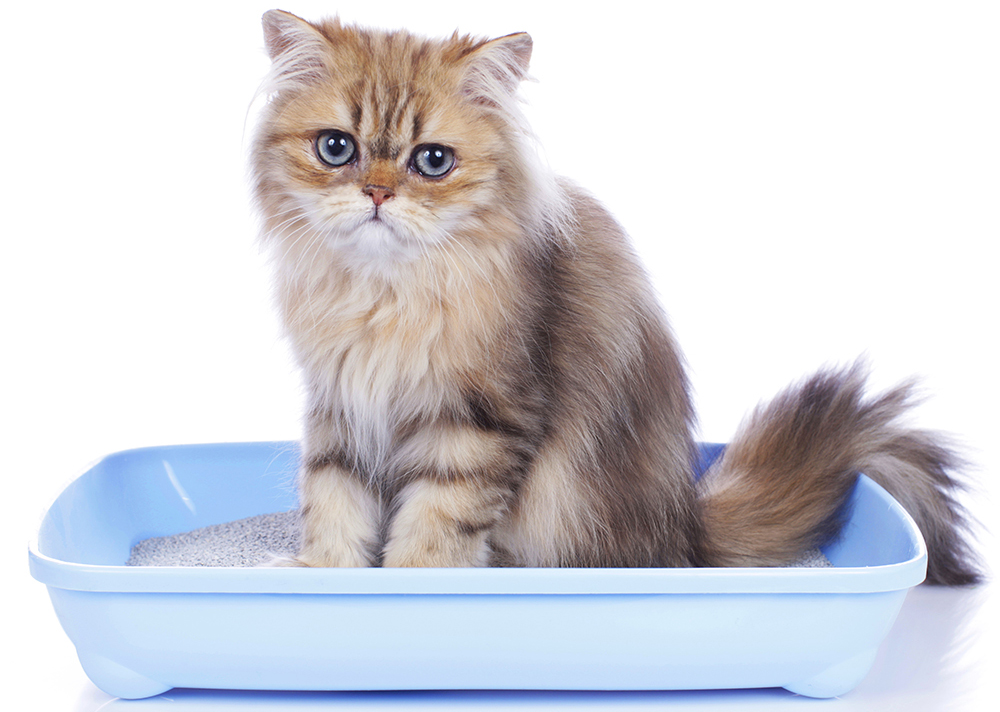 Cats are fastidious animals and can be easily trained to use a litter box. Cats are fastidious animals and can be easily trained to use a litter box.
|
Several different types of boxes and litter are available. The pan should be large enough to contain the litter particles kicked up by the cat as she buries her deposit. Boxes can be open or hooded; there’s even a self-cleaning box for owners who prefer to avoid the daily scooping.
Innovators are always looking for new products to help owners provide a good environment for their pets. So, along with hooded, open, and self-cleaning litterboxes, there are several types of litter and auxiliary products to encourage good elimination habits in indoor cats and make it easier for owners to control odor and keep things clean
There are clay litters, clumping litters, paper litters, and silica crystal litters; litter box screens and deodorizers; litterbox liners; and more, all geared to keep cat households clean and fresh.
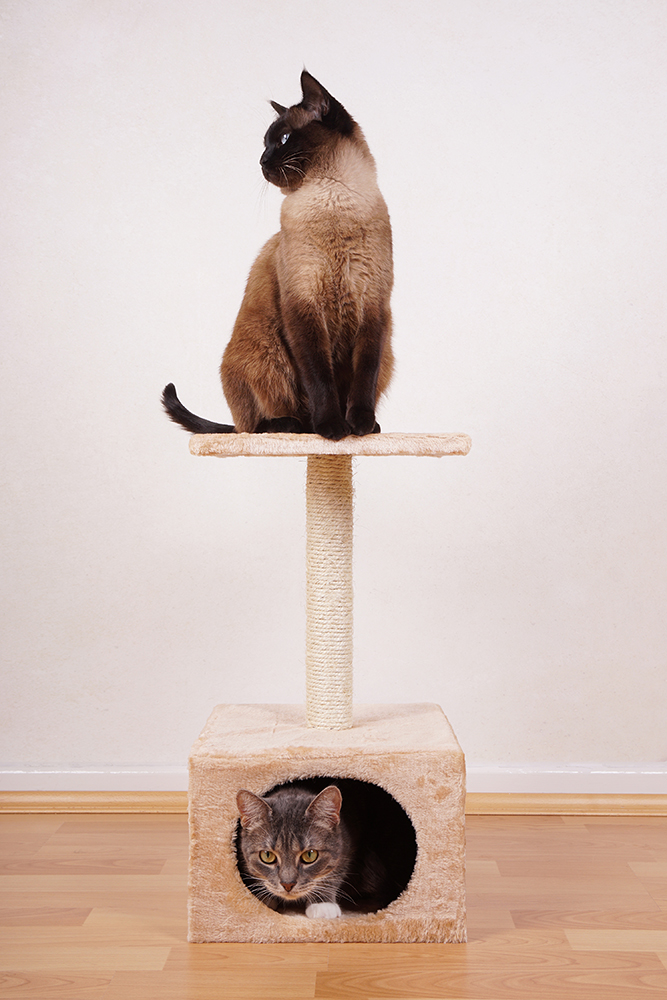 Cats love to climb! Cats love to climb!
|
It’s no secret that cats love to climb. This instinct aids them in hunting prey and hiding from predators. It’s simple: a cat up high can see more than a cat on the ground. So, if you prefer that Fluffy stay off the furniture, get a kitty gym with places to hide, perch, snooze, and set up ambushes.
Kitty gyms are especially fun for multiple-cat households. Cats can wait to pounce on housemates, chase each other up, down, and around, and observe their worlds from a variety of roosts. You can buy a kitty gym over the Internet or in a pet supply store.
While few people select a cat for anything other than a family companion, many cats are natural therapy animals, many will do tricks, and some will consent to training in agility and other activities.
Training a cat requires patience, food rewards, enticing toys, praise, and patience. Jill Archibald, agility coordinator for the Cat Fancier’s Association, encourages owners to be aware of their cat’s body language as cues to its readiness for training. Since cats are natural predators, they focus on movement and can be enticed to follow a lure over, through, and between obstacles. Once they perceive the lure as prey, they will generally chase, stalk, and pounce to reach it and traverse any obstacle in their way. When they successfully maneuver the jumps, tunnel, hoops, steps or weave poles, handlers should reward them with praise and treats.
More information on feline agility and videos that explain how to train the cat here.
 Bring on the clicker! Bring on the clicker!
|
A leash and collar are typical training tools for dogs, but cats don’t respond well to these aids. They do respond to food rewards, but it can be difficult to give them the reward at the moment that they have performed the required activity. So, bring on the clicker, a tool used by performance dog trainers and trainers in zoos and other exotic animal venues.
A clicker is a hand-held noisemaker used to mark the precise moment the animal performs the desired movement. The sound is a bridge between the performance and the reward. The trainer follows the sound with a treat reward, immediately at first, then at prolonged intervals as the cat learns what the trainer expects. For example, when using a clicker to teach cat agility, the initial click and reward sequence comes after the cat jumps over a single jump, then builds until the cat jumps several jumps before getting the sound and treat.
The first step is to “load the clicker” so the cat learns to connect the sound with the reward. It’s easy; just take a dozen or so small treats, get the cat’s attention, and repeatedly click then give a treat until the treats are gone. Use tempting treats the cat will get only during training sessions. Do this a couple of times a day until the cat looks for the treat when he hears the sound.
Second step is to wait a few seconds before giving the treat so the cat learns that the reward might take a few seconds to arrive.
Third step is to apply the click-treat sequence to any activity you want the cat to achieve. In the beginning, every success gets a click and treat. As the cat becomes more skilled, you can vary the interval between the performance and the reward. You can teach sit, high-five, lie down, roll over, crawl, dance, and many other tricks that enhance playtime with your pet, add variety to his life, and challenge your creativity. For more information, see animal trainer Karen Pryor’s website for clicker training ideas, procedures, and hints.
Clickers are available at pet supply stores and online pet retailers such as Drs. Foster and Smith.
If you don’t have a clicker or want to test the theory before buying one, you can use a ball point pen to mimic the sound.
Every cat that sits on a lap for petting or greets family members at the door provides comfort that can lower blood pressure and make the trials and tribulations of the day disappear. Cats listen to your woes, don’t criticize your actions or words, and generally take it all in stride.
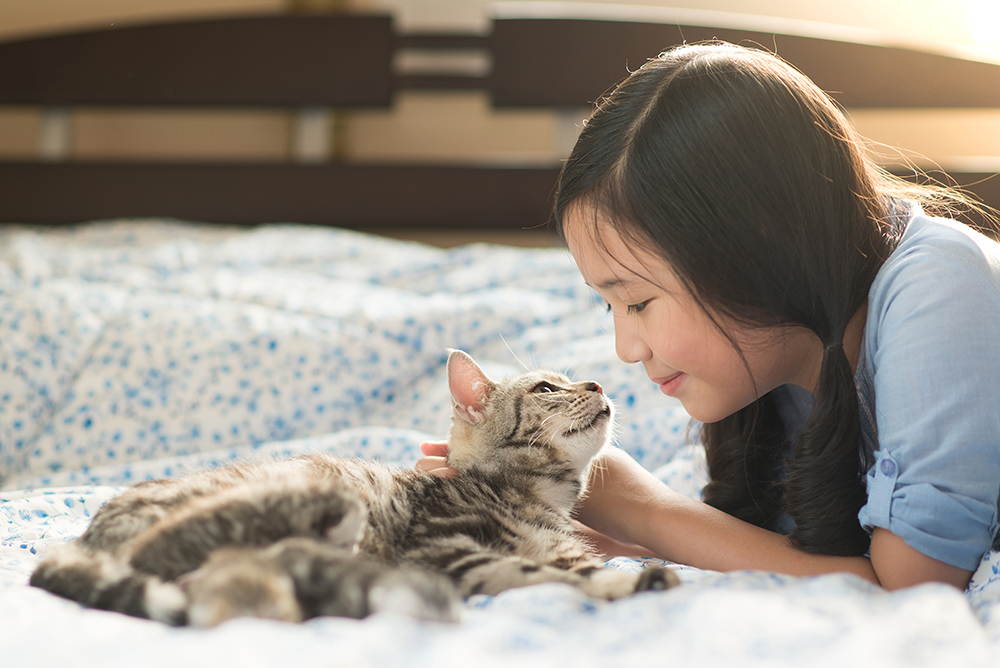 Some cats can make wonderful therapy animals. Some cats can make wonderful therapy animals.
|
Social workers, medical personnel, and others use this inherent calming ability to help clients and patients in nursing homes, hospitals, and other facilities. Some nursing homes and retiree centers have live-in cats to provide relaxation for patients and residents.
Most facilities require some evidence that cats are calm enough to interact with clients and patients. The Delta Society Pet Partners Program outlines the benefits and responsibilities of pets and their handlers and evaluates animals to participate.
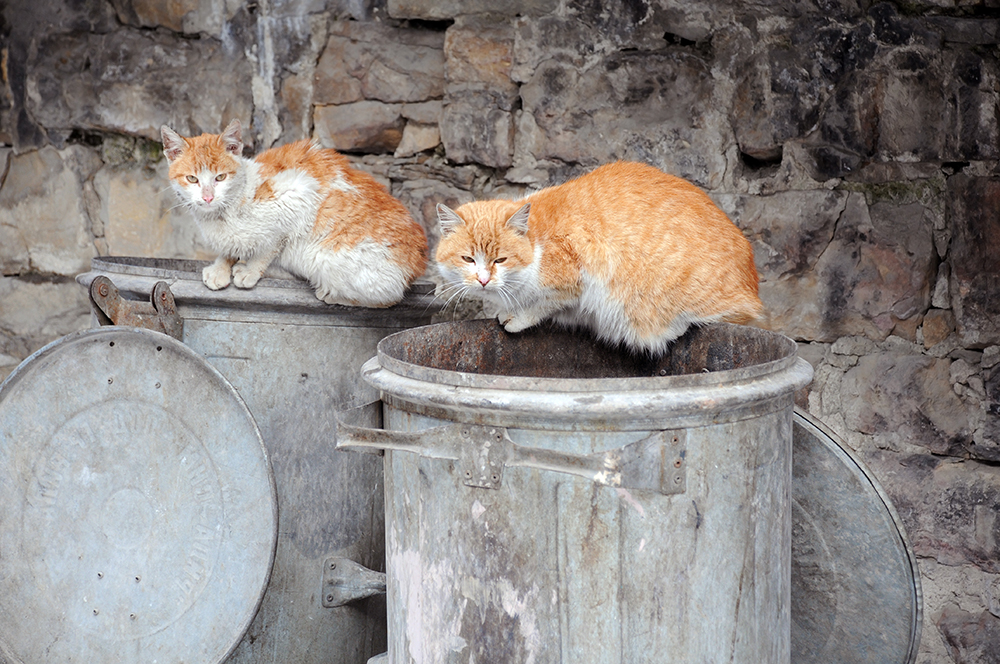 Strays are everywhere and native to nowhere. Strays are everywhere and native to nowhere.
|
Cats are everywhere but are native to nowhere. Popular and well-loved as pets, they are also genetically suited to a wild life in city back alleys, densely populated residential areas, suburban parks, barns, fields, campuses, wildlife sanctuaries, and other habitats where food is abundant and shelter is available. Cats that abandon an indoor life fall into two categories.
A stray cat is one that had a home but lost it. Many stray cats are escapees who yearn for adventure outside four walls, but a large number lose their homes when owners suffer a reversal of health or fortune and can no longer keep the pet. Many of these cats will fit nicely into a new household. Some stray cats are free-roaming unowned cats that are neighborhood pets visiting various homes for food, human company, and a place to sleep.
Adoption options
Cats can live 20 years or more, and some aging or ill owners find they can no longer provide for their pets’ welfare. Others adopt a stray that has kittens or take in a litter of abandoned kittens they cannot keep. Many of these cats end up at a shelter. Capital Area Humane Society in Central Ohio offers owners an opportunity to keep their pets until there is room at the shelter or until a potential adopter or volunteer foster home is available. If economic circumstances trigger the surrender, the shelter offers food, litter, and vet care. This policy reduced cat euthanasia at the facility by 58 percent from September 1-October 23, 2014.
A feral cat is one that lives on its own or in a loose colony of cats, perhaps in proximity to people but without much of a relationship with its human neighbors. Feral cats are often nuisances in communities, on campuses, in apartment complexes, and other areas where they can forage for scraps and hunt for rodents that frequent these locations. They yowl at night, leave feces and urine in gardens and children’s play areas, spread disease, kill birds and small mammals, fight, and reproduce. The life of a feral cat is not easy; they die of injuries and diseases and fall prey to coyotes and cars.
Some studies place the number of stray and feral cats at 60 million animals, a formidable population of an introduced species that has few natural enemies and a very successful reproductive scheme. Generally, state and local laws require animal control agencies to impound dogs running at large and pretty much ignore cats. Private shelters, with or without IRS charity status, try to take up the slack and provide short and long-term housing for strays and some feral cats. Groups such as Alley Cat Allies promote trap and release programs to control reproduction and diseases in feral cat colonies, but their success depends on local population dynamics and other factors. Finally, stories abound of individual cat lovers who take in strays or care for feral cat colonies in their neighborhoods.
Feral cats are a huge problem in many areas of the country. They often congregate in loose-knit colonies of dozens or hundreds or even 1000 or more. Some cat lovers subsidize the existence of these aggregations by establishing trap, neuter, and return programs to reduce reproduction and disease. They trap cats, pay for vaccinations, medical treatment, and sterilization surgery, and return the cats to their habitats. Volunteers feed the cats and monitor them for disease and injury. Some of these programs are financed by government budgets, some are supported by donations, and some use both methods of funding.
Domestic cats are not native to any habitat; their adaptive nature allows them to live in all but the coldest regions and their obsessive prey drive motivates them to hunt and kill even when they are not hungry. These characteristics make them a serious threat to birds and small mammals and a fierce rival of native predators such as skunks and hawks that hunt the same prey. Cat fleas are also vectors for several zoonotic diseases and cat feces can carry toxoplasmosis and other infections. However, TNR programs are based on concern for the cats, and proponents ignore or disregard the significant negative impact on wildlife and their potential as disease vectors. Government agencies grappling with growing feral cat populations often pounce on TNR as a way to prevent more cats from being born and may overlook the harm they do when returned to their habitat.
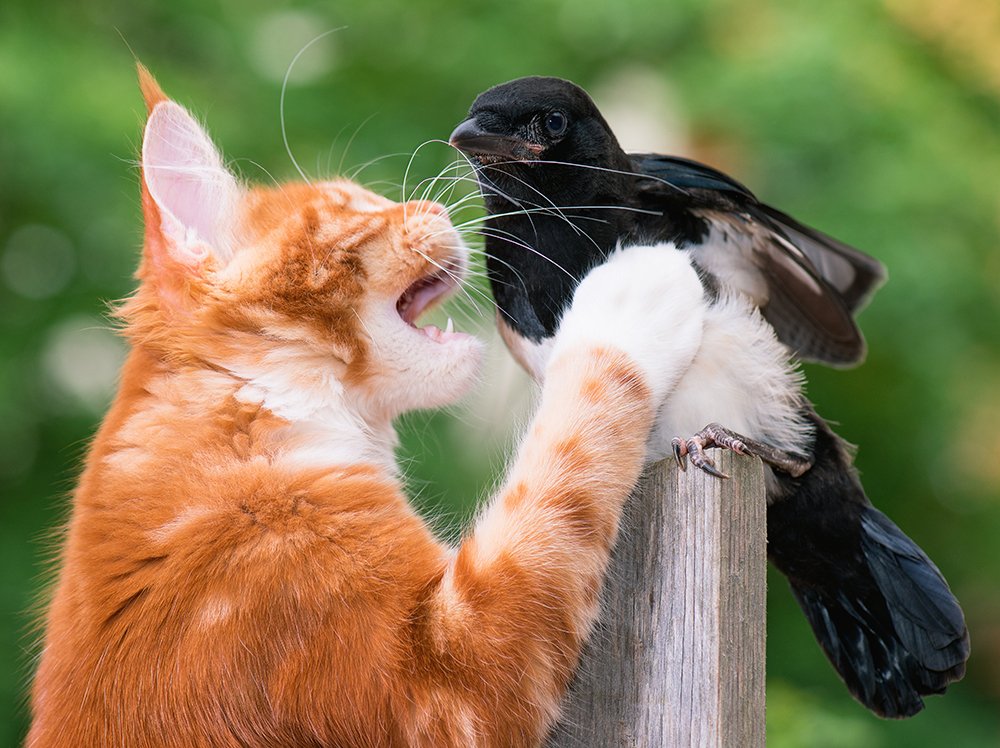 Feral cat predation can have a devastating effect on endangered species. Feral cat predation can have a devastating effect on endangered species.
|
Studies indicate that feral cat predation on birds, mammals, amphibians, and reptiles is substantial and can have a devastating effect on endangered and threatened species, especially in areas where habitat is fragmented or nesting will be disturbed. Environmental impact statements are not required to institute colony management even though some colonies are in or near protected wildlife areas or endangered species habitats. In addition there is evidence that a sterilization program does not keep new intact cats from entering a colony and is therefore ineffective at population control.
The American Veterinary Medical Association published two papers about feral cats and TNR in the organization’s November 1, 2004, edition of the association’s journal. “Professional, ethical, and legal dilemmas of trap-neuter-release” and “The welfare of feral cats and wildlife” both address the issue of feral cat colonies as they affect wildlife, public health, and veterinary ethics and recommend options to TNR.
Opponents of TNR programs include The Wilderness Society, many local and regional Audubon societies, and the American Bird Conservancy. In January 2014, a coalition of wildlife conservation groups sent their concerns to US Secretary of the Interior Sally Jewell and asked her to devise a plan to deal with feral cats on federal lands. Their letter puts the number of deaths due to cats at more than two billion birds and more than 12 billion mammals.
Support for managed cat colonies comes from such groups as the Humane Society of the US, the American Society for the Prevention of Cruelty to Animals, Alley Cat Allies, and local and regional animal shelters. The American Veterinary Medical Association neither supports nor endorses cat colonies but discourages their use in public parks, in areas that could threaten at-risk wildlife, and in places where the cats may pose a zoonotic risk to the public. Alley Cat Allies counters the naysayers with “Feral Cats and the Public—A Healthy Relationship.”
Developed by the American Bird Conservancy, Cats Indoors! Encourages cat owners to keep their pets inside and offers information to individuals, public agencies, and organizations seeking to educate cat owners about the dangers of letting cats roam or abandoning them to a life outdoors.
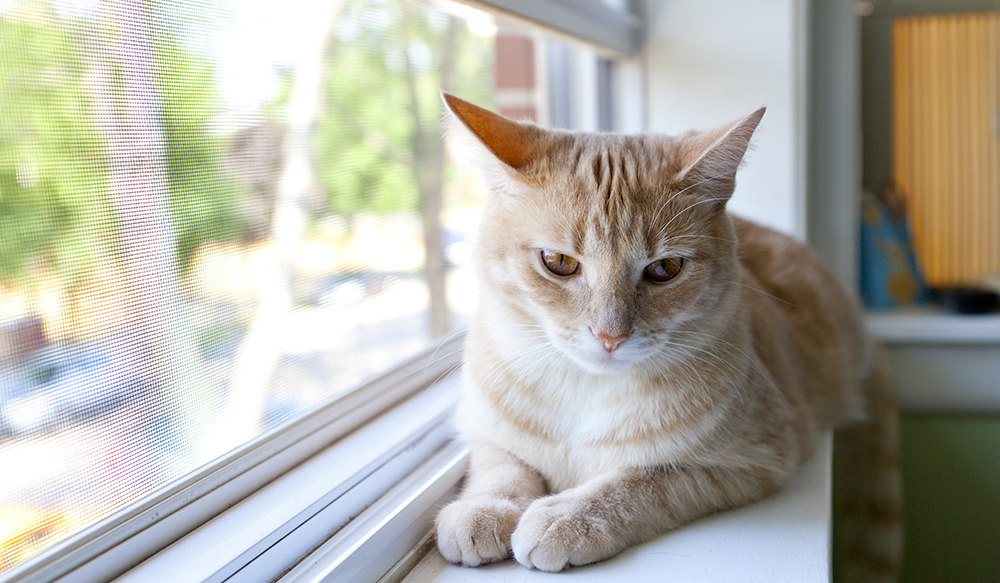 Indoor cat Indoor cat
|
Hints for cat owners include:
In addition:
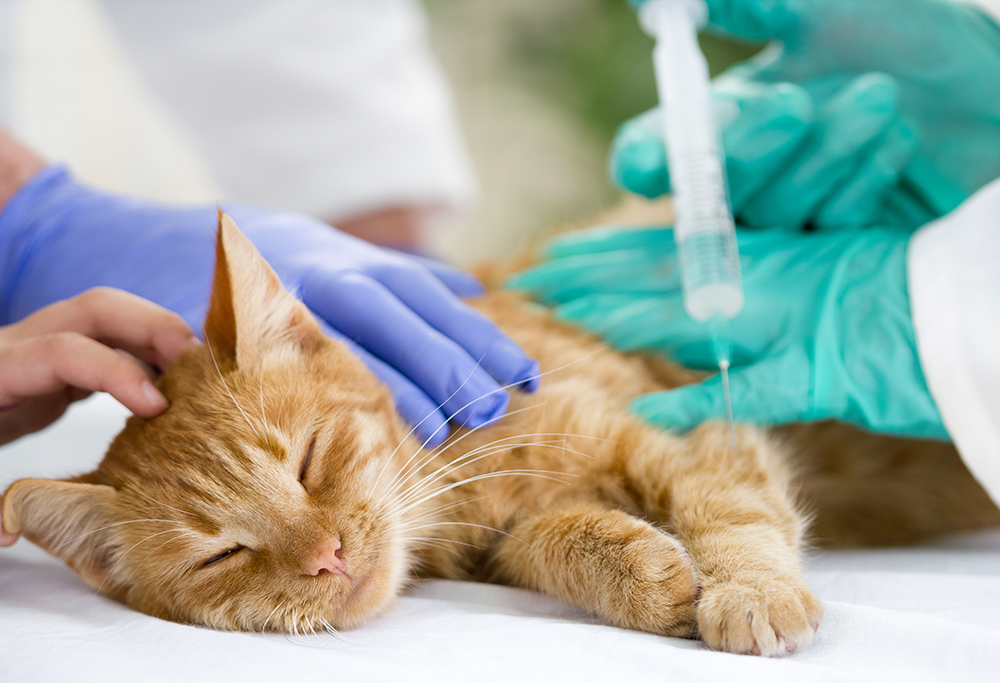 Like other animals, cats are subject to infectious diseases and genetic abnormalities. Like other animals, cats are subject to infectious diseases and genetic abnormalities.
|
Like other animals, cats are subject to infectious diseases and genetic abnormalities. Free-roaming cats are especially vulnerable to deadly viruses that exist in cat populations throughout the world, and male cats are generally more susceptible because they tend to roam and fight. Spread through contact with saliva, feces, urine, or nose-to-nose contact, many of these diseases can be prevented by vaccination, by keeping cats indoors, and by minimizing contact with cats that spend part of their time outdoors.
Cats tend to be stoic creatures and as such often hide illnesses, especially in the early stages. Cat owners can watch for subtle signs of sickness and discuss them with the veterinarian if they appear. In a nutshell, the signs are:
Feline Immunodeficiency Virus (FIV) is similar to Human Immunodeficiency Virus (HIV), the precursor to AIDS. FIV suppresses the cat’s immune system, leaving the animal vulnerable to other diseases and conditions ranging from gingivitis to diarrhea, pneumonia, skin disease, sinus infections and neurological problems. Many cats with FIV live long lives with early detection, routine care, and minimal exposure to other diseases. FIV can be prevented by vaccination.
Feline Infectious Peritonitis is a deadly infection caused by feline infectious corona virus (FICV), a mutated form of feline enteric coronavirus (FECV). The enteric form of the virus is common, is shed in feces, and does not cause disease; the mutation into FICV occurs within the individual cat and is not contagious.
Most cats that develop FIP are between the ages of six months and two years. Symptoms are vague and can include loss of appetite and resulting weight loss, lethargy, and a fluctuating fever that is not responsive to antibiotics. Prevention is difficult, but there is evidence of a genetic predisposition that affects cats in the same family lines. There is a vaccine available but the American Association of Feline Practitioners does not recommend it due to a lack of evidence about its effectiveness.
Feline Leukemia Virus (FeLV) is a world-wide disease of cats and is especially problematic in dense populations such as managed cat colonies and multi-cat households, especially if the cats have access to outdoors. FeLV is spread through body fluids, especially saliva; cats can become infected from bites received in fights, from sharing food dishes and litter boxes, and from licking and grooming each other. Kittens are at the greatest risk of acquiring the disease because their immune systems are not fully mature.
FeLV causes serious and widespread illnesses, including degenerative diseases, some types of cancer, and immunodeficiencies, among cats, but both a blood test to detect the disease and a vaccine to prevent it are available.
Chronic kidney disease affects nearly half of all cats that are more than 15 years old. Causes are largely unknown as there are many ways a cat’s kidneys can be damaged. Early diagnosis, good nutrition, drug therapy and at-home care can help a cat live for years following diagnosis.
Zoonotic diseases can affect humans and as such are critically important to cat owners. These are bacterial, fungal, parasitic, and viral diseases that can cause serious illness and death in people, especially children and adults who have compromised immune systems. Pregnant women are especially vulnerable to toxoplasmosis, a potentially fatal protozoal infection passed in cat feces.
Cats can spread zoonotic diseases through saliva, scratches, feces, urine, and vectors such as fleas. Good health practices that include vaccinations, stool checks, and worming can help prevent and control many of these diseases.
Zoonotic bacterial diseases include cat scratch disease and salmonella. Cat scratch disease, also known as bartonellosis, is the most common feline zoonotic bacterial infection with some 25 thousand human cases each year. Symptoms include fever, aches and pains, fatigue, and poor appetite. Although healthy adults usually recover without lasting effects, the disease can be more serious or even fatal in those with immature or damaged immune systems. Households with small children, elderly adults, and members with immune deficiencies should avoid rough play with cats, steer clear of stray or feral cats, keep pet cats indoors, and wash hands after playing with or handling pets.
Symptoms of Salmonella infection include diarrhea, fever, and stomach pain. Infected cats pass the bacteria in their stool. Salmanellosis is more common in cats that eat raw meat, birds, or small mammals; prevention involves feeding cats cooked or commercially-processed food, keeping cats indoors, and washing hands thoroughly after cleaning the litterbox.
Parasites that affect cats can also infect people. Fleas are the most common of these critters; flea bites can cause itching and inflammation in both cats and people and serve as vectors for cat scratch disease and other infections. Intestinal parasites such as roundworms and hookworms can cause serious disease; their eggs live in soil and can be ingested by children playing in the dirt or sandbox. Good preventive care is important; owners should have their pet’s stool checked for evidence of worms, use a worming product recommended by a veterinarian, practice good hygiene at home, and cover the sandbox when it’s not in use.
Ringworm is a fungal infection that is difficult to wipe out. Ringworm in cats appears as a dry, gray, scaly patch on the skin; in humans, it is a round red, itchy lesion. People get the fungus from contact with the infected cat’s skin or with an environment where the scaly flakes have fallen. Treatment includes bathing with special shampoo and perhaps oral medication, and eradication can take months.
Protozoa are single-cell organisms living in water and soil contaminated by the feces of infected animals. Protozoa such as giardia and cryptosporidia cause diarrhea in cats and people, but people usually get the infection from the common source, i.e., infected soil or water, not directly from the cat. Prevention includes annual fecal exams for the cat and good hygiene for the owner.
Toxoplasmosis is a different matter; people who handle cat waste can get the disease from an infected cat, and the infection can result in severe illness in those who have weakened immune systems and in babies whose mothers are infected during pregnancy. Cats contract toxoplasmosis by eating infected birds or rodents or by coming in contact with the feces of another contaminated cat. Once shed by the cat, the protozoa matures for five days before becoming infectious and can persist in the environment for months.
As with other zoonotic diseases, good hygiene goes a long way towards prevention. Wearing gloves when cleaning the litter box, washing hands after gardening in potentially-contaminated soil, covering the child’s sandbox, and filtering surface water before drinking should always be part of the protocol. And just to be safe, pregnant women and people with weakened immune systems should not clean the cat’s litterbox.
Most viruses infect only their natural host species. Human viruses, like those that cause the common cold, infect only humans, while feline immunodeficiency virus, feline infectious peritonitis virus, and feline leukemia virus infect only cats. However, one virus that can be passed from cats to humans is rabies, a viral disease resulting from the bite of an infected animal.
Cats are highly susceptible to rabies, which attacks the central nervous system, causing a variety of signs. Rabies is almost always fatal. In people, rabies infections usually occur when an infected animal bites a person. In order to protect human health, rabies vaccination of cats is required by law in many areas. Even if your cat is kept indoors, it is important to keep rabies vaccines current because cats occasionally escape outdoors, and because rabid animals such as bats and raccoons occasionally enter houses. To further reduce your risk of rabies, avoid contact with wildlife and stray animals. See a doctor immediately if you have been bitten by an animal.
So why a cat?
Cats have an allure that appeals to many people. Their haughty attitude, graceful beauty, air of inscrutability, connection to their wild brethren, and willingness to live with people on their own terms make them attractive pets to millions of people. Cats don’t need daily walks, don’t take up much room, and are generally quieter than dogs, so are good companions for people with physical limitations, people who live in apartments or condominiums, and people who work long hours and cannot return home to provide for a dog’s relief needs.
Recent research indicates that the bond between owners and cats is just as satisfying for both person and pet as the bond between owners and dogs, even though cats are more independent and less demonstrative than most dogs. Cardiologists know that pet owners reap health benefits from interaction with a pet, and research scientists have explored the role played by the hormone oxytocin in social interactions between pets and owners. Best known for its part in reproduction and infant care, oxytocin has a calming effect on other body systems as well and can help lower anxiety, tension, blood pressure, and cholesterol.
Studies also show that children who grow up with a pet are less likely to develop allergies as teenagers or adults, and pets provide structure to life, offer opportunities for social contact, and keep owners active. Even though cats don’t need daily walks or outside exercise, owners or caretakers must feed them, clean their litter boxes, provide grooming and veterinary care, and offer opportunities for interactive play.
 Discover Animals is a web-based educational resource offered by the NAIA
Discover Animals is a web-based educational resource offered by the NAIA